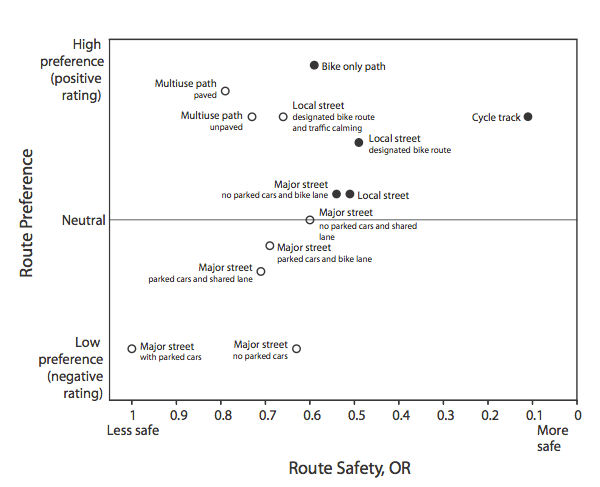
Urban bike commuters might want to study this graphic. It’s taken from a recent paper published in the and it shows injury risk based on the type of urban bike route taken by commuters. The further to the left a given route type sits, the higher the risk for injury. The higher up a route type sits, the more bicyclists favor it. It's probably not shocking that the highest risk of injury in the study was associated with bike routes on busy streets with parked cars and no bike lanes, but the Canadian scientists conducting the study were surprised by how much less risk they saw in protected bike lanes, which they call “cycle tracks.”
From May 18, 2008, to November 30, 2009, a group of scientists
contacted cyclists that reported injuries in five hospital emergency rooms in
Vancouver and Toronto. Roughly 2,335 cyclists reported injuries during that time. People injured while mountain biking, racing, or trick riding were excluded
from the survey. People who died or were judged to be too seriously injured to respond to a questionnaire were excluded as well. Children under the age of 19 were also excluded. In the
end, 690 people agreed to participate.
The scientists reached out to the cyclists and asked them a set of specific questions about their commute.
Scientists then visited the locations where each cyclist was injured and classified them into one of 14
different route types. They also randomly selected control sites on the same routes and classified those into one of the 14 different route types. The scientists then compared the odds of injury on each route type. (One of those route types was sidewalks, which was not shown in the graphic above because it was not included in the survey questions.)
The most dangerous route was a busy street with parked cars.
Cyclists who rode city streets with bike lanes and no parked cars experienced
half the risk of those who biked busy streets with parked cars. Cyclists who
rode in a bike lane physically separated from car traffic experienced 10
percent of the risk of busy streets with parked cars.
More than 72 percent of the injuries catalogued were a
result of collisions—with cars, people, other bikers, and animals.
Roughly a third of those collisions occurred with cars, and another 14
percent of injuries were indirectly caused by cars—i.e. swerving to get
out of the way. Roughly 28 percent of injuries occurred during falls. Other hazards that increased the odds of injury were railroad tracks, steep downhills, and construction.
Lead author Kay Teschke, of the University of British Columbia, offered a fairly simple takeaway for city planners: “That there are three types of route, for different circumstances, that
are excellent to both motivate cycling and prevent injuries: cycle
tracks alongside major city streets, residential street bikeways with
traffic diversion, and off-street bike paths.”
For commuters, the takeaway is even simpler: “That where you ride will make a difference to your safety,” says Teschke.
For more on the study, check out “,” in The Atlantic Cities (H/T), and “,” on the University of British Columbia’s website.
—Joe Spring